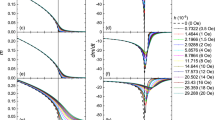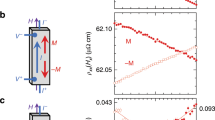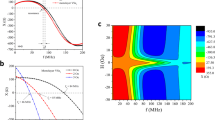Abstract
The resistance of a homogeneous semiconductor increases quadratically with magnetic field at low fields and, except in very special cases, saturates at fields much larger than the inverse of the carrier mobility, a number typically of the order of 1 T (refs 1, 2). A surprising exception to this behaviour has recently been observed in doped silver chalcogenides3,4,5, which exhibit an anomalously large, quasi-linear magnetoresistive response that extends down to low fields and survives, even at extreme fields of 55 T and beyond. Here we present a simple model of a macroscopically disordered and strongly inhomogeneous semiconductor that exhibits a similar non-saturating magnetoresistance. In addition to providing a possible explanation for the behaviour of doped silver chalcogenides, our model suggests potential routes for the construction of magnetic field sensors with a large, controllable and linear response.
This is a preview of subscription content, access via your institution
Access options
Subscribe to this journal
Receive 51 print issues and online access
$199.00 per year
only $3.90 per issue
Buy this article
- Purchase on Springer Link
- Instant access to full article PDF
Prices may be subject to local taxes which are calculated during checkout




Similar content being viewed by others
References
Kittel, C. Quantum Theory of Solids (Wiley, New York, 1963)
Smith, R. A. Semiconductors 2nd edn (Cambridge Univ. Press, Cambridge, 1978)
Xu, R. et al. Large magnetoresistance in non-magnetic silver chalcogenides. Nature 390, 57–60 (1997)
Lee, M., Rosenbaum, T. F., Saboungi, M.-L. & Schnyders, H. S. Band-gap tuning and linear magnetoresistance in the silver chalcogenides. Phys. Rev. Lett. 88, 066602 (2002)
Husmann, A. et al. Megagauss sensors. Nature 417, 421–424 (2002)
Dalven, R. & Gill, R. Energy gap in β-Ag2Se. Phys. Rev. 159, 645–649 (1967)
Tokura, Y. (ed.) Colossal Magnetoresistive Oxides (Gordon and Breach Science, New York, 2000)
Kapitza, P. L. The change of electrical conductivity in strong magnetic fields. Proc. R. Soc. Lond. A 123, 292–372 (1929)
Abrikosov, A. A. Quantum magnetoresistance. Phys. Rev. B 58, 2788–2794 (1998)
Büttiker, M. Magnetoresistance of very pure simple metals. Phys. Rev. B 42, 3197–3200 (1990)
Bruls, G. J. C. L., Bass, J., van Gelder, A. P., van Kempen, H. & Wyder, P. Linear magnetoresistance caused by sample thickness variations. Phys. Rev. Lett. 46, 553–555 (1981)
Beer, A. C. Solid State Physics Supplement 4: Galvanomagnetic Effects in Semiconductors (Academic, New York, 1963)
Reynolds, J. A. & Hough, J. M. Formulae for dielectric constant of mixtures. Proc. Phys. Soc. Lond. B 70, 769–775 (1957)
Balagurov, B. Ya. Conductivity of inhomogeneous media in strong magnetic fields. Sov. Phys. Solid State 28, 1694–1698 (1986)
Stroud, D. & Pan, F. P. Effect of isolated inhomogeneities on the galvanomagnetic properties of solids. Phys. Rev. B 13, 1434–1438 (1976)
Bergman, D. J. & Stroud, D. G. High-field magnetotransport in composite conductors: Effective medium approximation. Phys. Rev. B 62, 6603–6613 (2000)
Herring, C. Effect of random inhomogeneities on electrical and galvanomagnetic measurements. J. Appl. Phys. 31, 1939–1953 (1960)
Dreizin, Yu. A. & Dykhne, A. M. Anomalous conductivity of inhomogeneous media in a strong magnetic field. Sov. Phys. JETP 36, 127–136 (1973)
Solin, S. A., Thio, T., Hines, D. R. & Heremans, J. J. Enhanced room-temperature geometric magnetoresistance in inhomogeneous narrow-gap semiconductors. Science 289, 1530–1532 (2000)
Solin, S. A., Thio, T. & Hines, D. R. Controlled GMR enhancement from conducting inhomogeneities in non-magnetic semiconductors. Physica B 279, 37–40 (2000)
Ogorelec, Z., Hamzic, A. & Basletic, M. On the optimisation of the large magnetoresistance of Ag2Se. Europhys. Lett. 46, 56–61 (1999)
Acknowledgements
P.B.L. thanks the NHMFL for hospitality during the final drafting of this Letter. The NHMFL is supported by the National Science Foundation, the state of Florida and the US Department of Energy. This work was supported by the Association of Commonwealth Universities and the Cambridge Commonwealth Trust.
Author information
Authors and Affiliations
Corresponding author
Ethics declarations
Competing interests
The authors declare that they have no competing financial interests.
Rights and permissions
About this article
Cite this article
Parish, M., Littlewood, P. Non-saturating magnetoresistance in heavily disordered semiconductors. Nature 426, 162–165 (2003). https://doi.org/10.1038/nature02073
Received:
Accepted:
Issue Date:
DOI: https://doi.org/10.1038/nature02073
Comments
By submitting a comment you agree to abide by our Terms and Community Guidelines. If you find something abusive or that does not comply with our terms or guidelines please flag it as inappropriate.



